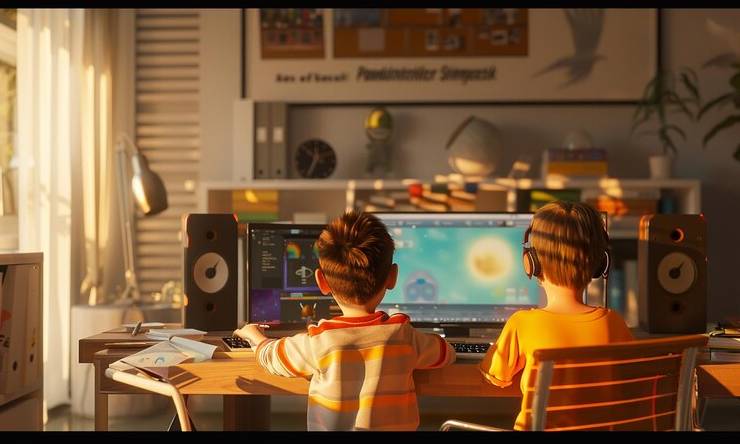2D animation has been a cornerstone of visual storytelling for over a century, evolving from simple, hand-drawn images to sophisticated digital creations that captivate audiences worldwide. In today’s media landscape, 2D animation continues to thrive, adapting to new technologies and platforms while preserving its artistic roots. This blog explores the evolution of 2D animation, its impact on modern media, and the role of 2d animation services in this dynamic industry.
The Birth of 2D Animation
The origins of 2D animation can be traced back to the late 19th century when pioneers like Émile Cohl and J. Stuart Blackton experimented with sequential images to create the illusion of movement. These early animations were rudimentary, often consisting of simple stick figures or basic shapes. However, they laid the foundation for what would become a revolutionary art form.
In 1908, Émile Cohl’s Fantasmagorie was one of the first fully animated films, featuring a series of hand-drawn images photographed one frame at a time. This film demonstrated the potential of 2D animation to tell stories in a way that no other medium could, sparking interest and innovation in the field.
The Golden Age of 2D Animation
The 1920s and 1930s marked the beginning of the Golden Age of 2D animation, characterized by the rise of major animation studios and the creation of iconic characters. Walt Disney Studios, established in 1923, played a pivotal role in this era, introducing the world to Mickey Mouse in Steamboat Willie (1928). This short film was groundbreaking not only for its animation but also for its synchronized sound, which added a new dimension to the storytelling experience.
The success of Steamboat Willie led to a series of innovations in 2D animation, including the introduction of Technicolor in the 1932 film Flowers and Trees. This was the first full-color cartoon, and it set the stage for the creation of longer, more complex animated films. Disney’s Snow White and the Seven Dwarfs (1937) was the first-ever feature-length animated film, showcasing the artistic and technical capabilities of 2D animation. This film’s success solidified animation as a legitimate form of cinematic art and opened the door for other studios to explore the medium.
The Rise of Television and 2D Animation
The 1950s and 1960s saw a shift in the 2D animation landscape with the rise of television as a dominant form of entertainment. Animation studios began producing content specifically for TV, leading to the creation of beloved series like The Flintstones (1960), The Jetsons (1962), and Scooby-Doo, Where Are You! (1969). These shows were often produced on tighter budgets and schedules than feature films, which led to the development of limited animation techniques. These techniques, such as reusing backgrounds and reducing the number of frames per second, allowed studios to produce content more efficiently while still delivering engaging stories.
The transition to television also introduced animation to a broader audience, making it a staple of family entertainment. The success of these animated TV shows spurred further innovation in the industry, leading to the creation of more sophisticated and diverse content in the following decades.
The Digital Revolution: Transforming 2D Animation
The late 20th and early 21st centuries brought about a digital revolution that transformed the 2D animation industry. The introduction of computers and digital software revolutionized the animation process, making it faster, more efficient, and accessible to a wider range of artists and studios.
One of the most significant advancements was the development of digital ink and paint systems, which replaced traditional hand-painted cels. This shift not only streamlined the production process but also allowed for greater consistency and control over the final product. Software like Adobe Flash (now Adobe Animate) became popular tools for animators, enabling them to create high-quality animations with ease.
The rise of digital animation also led to the resurgence of 2D animation in feature films and television. Studios like Disney and DreamWorks began integrating digital techniques with traditional animation, resulting in visually stunning films like The Lion King (1994) and The Prince of Egypt (1998). These films showcased the potential of digital tools to enhance the artistry of 2D animation without compromising its unique aesthetic.
The Role of 2D Animation in Modern Media
Today, 2D animation remains a vital part of the entertainment industry, with a diverse range of applications across various media platforms. From television and film to video games and online content, 2D animation continues to captivate audiences with its timeless appeal.
One of the key reasons for the enduring popularity of 2D animation is its versatility. Unlike 3D animation, which often requires complex modeling and rendering, 2D animation can be created with relatively simple tools and techniques. This accessibility has made it a popular choice for independent creators and small studios, allowing them to produce high-quality content without the need for extensive resources.
Moreover, 2D animation services have become increasingly specialized, catering to the needs of businesses and organizations looking to create engaging content for marketing, education, and communication purposes. Animated video companies offer a wide range of services, from explainer videos and advertisements to training modules and social media content. These services leverage the power of 2D animation to convey complex ideas and messages in a clear and visually appealing manner.
The Influence of Streaming Platforms on 2D Animation
The advent of streaming platforms like Netflix, Hulu, and Disney+ has further expanded the reach and influence of 2D animation. These platforms have provided animators with new opportunities to showcase their work and connect with global audiences. As a result, there has been a resurgence of interest in 2D animated series and films, with streaming services investing heavily in original animated content.
For instance, Netflix has produced and distributed a wide range of 2D animated series, including critically acclaimed shows like BoJack Horseman (2014-2020) and Castlevania (2017-2021). These series have pushed the boundaries of what 2D animation can achieve, exploring mature themes and complex narratives that appeal to both adult and younger audiences.
The success of these shows has also encouraged other streaming platforms to invest in 2D animation, leading to a renaissance of the medium in modern media. This trend has provided opportunities for both established studios and independent creators to experiment with new styles, techniques, and storytelling methods.
The Future of 2D Animation
As technology continues to evolve, the future of 2D animation looks brighter than ever. Advances in software and hardware are enabling animators to push the boundaries of what is possible, creating more detailed and dynamic animations than ever before.
One of the most exciting developments is the integration of 2D and 3D animation techniques, resulting in a hybrid style that combines the best of both worlds. This approach allows animators to create visually stunning animations that retain the charm and simplicity of traditional 2D animation while incorporating the depth and realism of 3D elements. Films like Spider-Man: Into the Spider-Verse (2018) have demonstrated the potential of this hybrid style, winning critical acclaim and setting new standards for animated storytelling.
Additionally, the growing popularity of virtual and augmented reality is opening up new possibilities for 2D animation. Animators are now exploring how to create immersive experiences that blend traditional 2D animation with interactive elements, allowing audiences to engage with animated content in new and exciting ways.
Conclusion: The Enduring Legacy of 2D Animation
The evolution of 2D animation in modern media is a testament to the enduring appeal and versatility of this art form. From its humble beginnings as a series of hand-drawn images to its current status as a global entertainment phenomenon, 2D animation has consistently adapted to new technologies and cultural trends while preserving its unique artistic identity.
As 2d animation services continue to play a crucial role in the industry, animated video companies are poised to lead the charge in creating innovative and engaging content that resonates with audiences across the world. Whether through traditional hand-drawn techniques or cutting-edge digital tools, the future of 2D animation is bright, promising new opportunities for creativity, storytelling, and artistic expression.
The legacy of 2D animation is one of innovation, resilience, and boundless creativity, ensuring that this beloved art form will continue to captivate and inspire generations to come.




